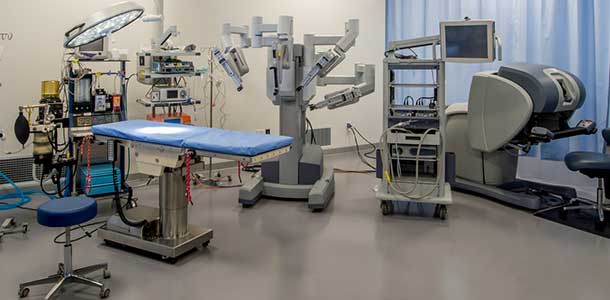Minimally Invasive Robotic Surgery
Spring Valley Hospital Medical Center surgeons use the da Vinci® Surgical System, an advanced robotic platform that allows doctors to perform complex procedures using smaller incisions than standard surgery with tiny, precision tools operated robotically. This may result in less pain, scarring, trauma and blood loss than other surgical procedures so that patients can potentially return to work and daily activities more quickly.
Robotic Procedures
Surgeons at Spring Valley Hospital are using the technology for:
- Prostate procedures
- Gynecologic procedures (including Single-Site Hysterectomy)
- Kidney surgery
- Gallbladder surgery
- General surgery (gallbladder, colon resections, hernia repairs, liver, Nissen fundoplication – for reflux)
The da Vinci System
The da Vinci® Surgical System consists of a surgeon's console, a patient-side cart with four interactive robotic arms, a high-performance 3D, high-definition vision system and the system's EndoWrist® instruments. Using advanced robotic technology, the da Vinci System is designed to translate a surgeon's hand movements into precise movements of the EndoWrist instruments.
Minimally-Invasive and Robotic Advantages
Both robotic surgery and laparoscopic surgery are known as minimally invasive procedures. In both procedures, small incisions are used, which may result in less post-operative pain, reduced blood loss, less need for blood transfusions and a potentially faster recovery time. The two major drawbacks of conventional laparoscopy (without the use of robotic instrumentation) are that it relies on the use of rigid, hand-held instruments, and visualization is provided by a standard 2D video monitor rather than a 3D field. While standard laparoscopic surgery is performed using small incisions, the surgeon's depth of field, dexterity and precision may be variable.
Potential benefits of minimally invasive robotic surgery over open surgery include:
- Shorter hospital stay (one day in most cases versus three to five days)
- Significantly less pain post-operatively (often only over-the-counter pain medications are required)
- Quicker recovery and return to normal activities (one to two weeks versus six to eight weeks)
- Fewer complications and less risk of infection
- Less scarring: Small, dime-sized incisions versus a six- to eight-inch scar.
Best Candidates
The best candidates for robotic surgery are chosen on an individual basis by your doctor. Ask him or her about robotic surgery and whether or not your diagnosis and situation will lend itself to robotic surgery.

